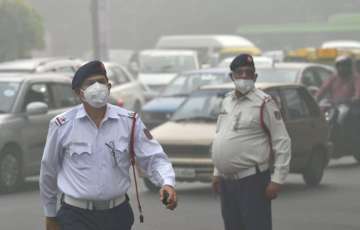Delhi govt calls off odd-even scheme, says will 'consider' if NGT grants exemptions to women, two-wheelers
The Delhi government on Saturday called off the propose odd-even scheme in the national capital that was scheduled to be implemented from November 13 to November 17.
The odd-even scheme is not returning to Delhi on Monday, the Delhi government said today, expressing its inability to enforce the measure after the National Green Tribunal ordered the withdrawal of exemptions given to women and two-wheelers.
The government said it will move the NGT on Monday requesting a review of its order and if the exemptions are granted, the scheme's implementation "will be considered".
After a meeting chaired by Chief Minister Arvind Kejriwal, Transport Minister Kailash Gahlot announced that the measure, which was to be implemented between November 13 and 17, was being "called off" as the number of buses were inadequate and women's safety could not be compromised.
In a statement, the government later said that it has decided to "defer" its implementation. Gahlot said the authorities are ready to roll it out immediately if the exemptions are granted.
The NGT, which gave a conditional nod to the scheme, said that it should be implemented as and when PM (particulate matter) 10 level goes above 500 micrograms per cubic metre and PM 2.5 level crosses the limit of 300 micrograms per cubic metre and persist for 48 hours at a stretch.
At around 3.30 pm, Environment Minister Imran Hussain said the levels of PM2.5 and PM10 had also dropped. But by evening, the pollution was back to 'emergency' levels and a thick haze descended on the city.
The Centre-run monitoring agency SAFAR (System of Air Quality and Weather Forecasting And Research) attributed the rise in pollution to the lowering of the "boundary layer" keeping pollutants trapped near the surface and preventing their escape into the upper layer of the atmosphere.
"There is no likelihood of last week's repeat as there is no fresh influx of pollutants from external sources such as stubble burning or dust storm in the larger region. But recovery will get delayed by at least one more day," SAFAR project director Gufran Beig told PTI.
The hourly graph of the Central Control Room for Air Quality Management run by the Central Pollution Control Board (CPCB) also captured the sudden change in the air quality.
The concentration of PM2.5 and PM10 hovered around 490 and 290 micrograms per cubic metre during the morning hours, marginally below the emergency limit of 500 and 300.
But by 6 pm, the readings had changed to 522 and 332. In fact, the improvement in the air quality made during the day started diminishing from around 2 pm itself.
The corresponding safe standards are 60 and 100 and prolonged exposure to anything beyond that is considered hazardous to human health as these particulates, measuring up to 30 times finer than the width of a human hair, can enter the respiratory system and settle deep in the lungs and also enter the bloodstream.
The CPCB's air quality index for the day (based on pollution levels till 5 pm) had a score of 403, as against yesterday's 468.
Beig said the drop in both the minimum and maximum temperatures led to the coming down of the boundary layer from around 1600 metres from the surface at 11 am to 50 metres at 5 pm.
According to the weather office, the maximum and minimum temperatures were 12.6 and 28.3 degrees Celsius respectively. The minimum was a notch below the season's average, it said.
Earlier this week, the Delhi government had announced implementation of the odd-even scheme from November 13 to 17, given the high level of smog in the capital. Schools were also shutdown till Sunday.
The car-rationing scheme was enforced twice in the national capital in 2016 with the two exemptions which were today struck down by the NGT.
Under the policy, private vehicles are allowed to run based on the last number of their license plates. Odd-numbered cars are allowed to run on odd dates while even-numbered cars can only run on even dates.
Yesterday, AAP's Delhi unit convenor and Labour Minister Gopal Rai had strongly defended the scheme, terming vehicular pollution as the biggest source of ultrafine particulate matters measuring less than 2.5 microns.
A landmark IIT-Kanpur study, which covered the period 2013-14, has said that during winters, vehicles are the second largest and the "most consistent" contributing source of pollutants PM10 and PM2.5.
In terms of percentage, it comes to around 20-25 per cent during winters, the report says. The contribution of road dust is negligible during the colder months unlike summers when it plays a bigger role.
However, the share of two-wheelers, three-wheelers, four-wheelers, trucks and light commercial vehicles in the total vehicular contribution shows that trucks and two-wheelers are the major polluters.
According to the study, which was commissioned by the Sheila Dikshit government, the share of four-wheelers in the break up of vehicular contribution is 10 per cent each in cases of both PM2.5 and PM10.
On the other hand, the share of trucks and two-wheelers stands at around 46 per cent and 33 per cent respectively.
